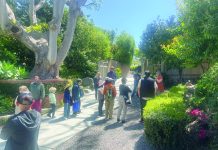Wildlife

The name of this column is Pet Peeves. Pivotal word here is pet. So, I’m reluctant to respond to the Indy article, “Multi-Year Wildlife Camera Study Shows Worrying Trend.” Pivotal word there is wildlife. See, I’m scared of my own pets, so I can’t imagine going out into the Laguna Greenbelt to stick my nose up a bobcat’s ### to get the inside story. I suggested to the editor an alternative column about my pet goldfish swimming inside a glass bowl, a safe distance from me.
“Nobody cares about your pet goldfish, Crantz. Get out there and capture the wild.” I try throwing a Hail Mary. “If you want to capture wildlife how about a column about the patrons at Mozambique?” The editor gave me that steely look pet owners have right before they roll the newspaper and smack you in the nose with it. Her glare took the fight right of me. “Okay. Wildlife it is. Great idea. Can I expense firearms?” Smack. Geez, my nose hurt. The Indy sure has some hard news in it.
Laguna Greenbelt, a local environmental organization planned and executed a study of activity in a wildlife corridor connecting the Laguna Coast Wilderness Park to the Cleveland National Forest. Fifty volunteers used 21 cameras to examine the migration pattern over a two-year period. At the end, two volunteers were left to report their findings. The 48 who didn’t make it back can be seen being mauled and eaten on snuff films on the dark web. A surviving volunteer reported, “These brave men and women gave their lives to preserve nature. They did not die in vain. We’ve learned from them to better encrypt cameras now, so film bootleggers cannot use footage for their own sick monetary gains. We do not recommend surfing for this footage. The grisly nature of these attacks can easily be misconstrued. It was not the animal’s fault. They were just being animals. We’ve learned that wild animals eat you, if they are hungry. It’s no different than when you’re hungry and eat the “animal” at In-N-Out Burger.
Since the late 1990s, progress has been made on finishing the 6-mile long corridor, focused at providing safe animal passage through the urban landscape to adjacent conservation areas in Laguna and the inland hills. According to a Department of Transportation spokesman, road kill is down 70 percent. “Our jobs are much easier now because of these safer corridors. Before these corridors were put in place, the unemployed would run into traffic to retrieve mowed done pelts to sell them to discount furriers. In the 1980s, run-over furs showing tire tracks were must have clothing on college campuses.
But the biggest surprise finding was a lowering use of animal migration along the corridor. Experts believe the problem is no animal of average intelligence wants to go to Cleveland. Animals have long memories when the Cuyahoga River caught fire in 1952.
Crantz tells the Indy that a new study is underway to look into changing the Cleveland name to Hollywood National Forest, a friendlier place that promotes and pays for animals’ on camera work.




